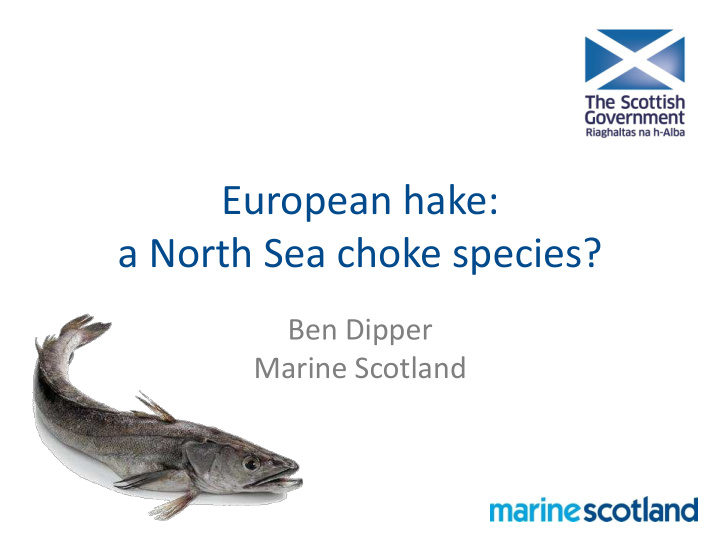



European hake: a North Sea choke species? Ben Dipper Marine Scotland
What is the issue? • Northern hake global TAC • TAC distribution does not seem to be in any way closely aligned with stock distribution • Significant and on-going changes in the stock abundance and distribution • Implications pose challenges to most, if not all, member states fishing in the North Sea
Distribution • European hake - widely distributed • Highest densities Bay of Biscay and west Ireland/UK • Northern and southern stocks • Limited knowledge of stock in northern areas
Observed densities
Regional biomass estimates Q3 Q1 North Sea: increase by a factor 8 in quarter 3 (factor 4 in quarter 1)
Looking ahead
Why? Fishing & 2004 recovery plan TSB SSB
Why? Seasonal migration Significant relationships observed North Sea length frequencies: between hake landings distribution, more large individuals at Q3 and both temperature and depth Quarter 1 Quarter 3 Monthly distribution of UK hake landings (kg) 2000 to 2011 (note Q3: July-September)
TAC arrangements • Historic split of global TAC between basins doesn’t align with current distribution of stock • Additional layer of constraint beside RS • Insufficient quota in North Sea: 4% of TAC but 34% of biomass in Q3 • Supports what fishermen tell us
A possible solution • Not enough fish allocated to North Sea (4%) to cover catches • Changing shares, swapping within basin and flexibility are not complete viable solutions • For hake, a wealth of scientific and catch information to assist making informed choices • An evidence based and scientifically justified approach may be one option
A science-based solution • We suggest the North Sea 2014 NS TAC (tonnes) 2,874 HLG should seek ICES or STECF advice on a new 2014 EU landings (tonnes) 4,428 allocation of the global TAC between regional basins 2014 STECF North Sea discard rate 40.34% that better reflects current stock abundance and Total catch (tonnes) 7,421 distribution • Such a science-based EU surplus/deficit (tonnes) -4,548 increase in the allocation of the global TAC to the North EU total catch as % of global TAC 9.07% Sea has potential to solve choke challenge
Associated issues • Implications for other TAC areas: – additional share for North Sea would have to come from other TAC areas; although there is NO change to RS, this would reduce quota previously available – “Robbing Peter to pay P aul”: don’t move the problem from one basin to another • Depending on level of revision, deficits may remain at Member State level within North Sea: – swaps and/or use of flexibility required, but may be more difficult under increasing stock scenario (LO, new fisheries) – given evolving distribution (climate change?), periodic review of the advice (every 5 years or so?) may be prudent
Conclusions • Significant seasonal increases in North Sea abundance and distribution, and changes in migration • Allocation from global TAC to North Sea basin doesn’t match where the fish are found • Insufficient quota in North Sea creates a significant choke risk under landing obligation • Scientific advice should be sought on reviewing, and periodically revisiting, the allocation to the North Sea • Regional quota trading and use of inter-area flexibilities may still be required
Thank you
Recommend
More recommend